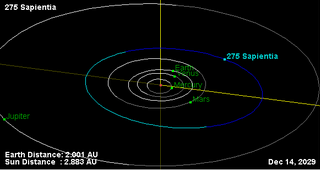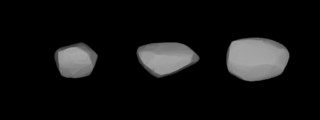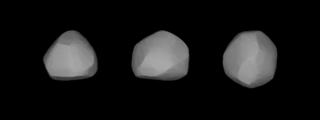Related Research Articles

191 Kolga is a large, dark main-belt asteroid that was discovered by German-American astronomer C. H. F. Peters on September 30, 1878, in Clinton, New York. It is named after Kólga, the daughter of Ægir in Norse mythology.

Ambrosia is a main belt asteroid that was discovered by the Corsican-born French astronomer J. Coggia on February 28, 1879, and named after Ambrosia, the food of the gods in Greek mythology.

Atropos is a typical Main belt asteroid that was discovered by Austrian astronomer Johann Palisa on 8 March 1888 in Vienna.

Sapientia is a very large Main belt asteroid that was discovered by Johann Palisa on 15 April 1888 in Vienna. It is classified as a C-type asteroid and is probably composed of carbonaceous material. It is named for the Roman personification of wisdom, Sapientia.

Corduba is a very large main-belt asteroid that was discovered by the French astronomer Auguste Charlois on 21 March 1893 from Nice. It is classified as a C-type asteroid and is probably composed of carbonaceous material.

Ducrosa is a typical Main belt asteroid. It was discovered by Auguste Charlois on 15 March 1895 in Nice.
Cheruskia is a minor planet, specifically an asteroid orbiting in the asteroid belt that was discovered by German astronomer Paul Götz on 26 July 1905 from Heidelberg.

Recha is a minor planet, specifically an asteroid orbiting in the asteroid belt between Mars and Jupiter. The asteroid, discovered by German astronomer Max Wolf on September 19, 1905, was named after a character in Gotthold Ephraim Lessing's play Nathan the Wise and may have been inspired by the asteroid's provisional designation 1905 RC.

Rebekka is a minor planet orbiting the Sun, which was discovered on September 19, 1905, by a German astronomer Paul Götz in Heidelberg. It was named after a young lady from Heidelberg, and may have been inspired by the asteroid's provisional designation 1905 RB.
Bilkis is a minor planet, specifically an asteroid orbiting in the asteroid belt. It was discovered by German astronomer August Kopff in 1906 February and was given the Koran name for the Queen of Sheba. Photometric observations at the Palmer Divide Observatory in Colorado Springs, Colorado in 2006–7 were used to build a light curve for this object. The asteroid displayed a rotation period of 8.5742 ± 0.0005 hours and a brightness variation of 0.40 ± 0.02 in magnitude.

Juvisia is a minor planet, specifically an asteroid orbiting in the asteroid belt that was discovered 27 August 1906 in Heidelberg by German astronomer Max Wolf. It was named after the commune Juvisy-sur-Orge, France, where French astronomer Camille Flammarion had his observatory.
607 Jenny is a minor planet, specifically an asteroid orbiting in the asteroid belt that was discovered by German astronomer August Kopff on September 18, 1906.
620 Drakonia is a minor planet, specifically an asteroid orbiting in the asteroid belt. It was discovered October 26, 1906, in Taunton, Massachusetts, by American astronomer Joel Hastings Metcalf and given the preliminary designation 1906 WE. It may have been named for Drake University.
639 Latona is a minor planet, specifically an asteroid orbiting in the asteroid belt. It was discovered by German astronomer Karl Lohnert on July 19, 1907, at Heidelberg.
687 Tinette is a minor planet, specifically an asteroid orbiting primarily in the asteroid belt. It was discovered by Austrian astronomer Johann Palisa on 16 August 1909 from Vienna and was given the preliminary designation 1909 HG.

708 Raphaela is a minor planet orbiting the Sun.

747 Winchester is an asteroid, a minor planet orbiting the Sun. It was discovered in 1913, and is named after the town in which it was discovered, Winchester, Massachusetts, in the USA.
793 Arizona is a minor planet orbiting the Sun that was discovered April 9, 1907 by American businessman Percival Lowell at Flagstaff. It was named for the state of Arizona. The object was independently discovered on April 17, 1907, by J. H. Metcalf at Taunton. This is a main belt asteroid orbiting 2.8 AU from the Sun with a period of 4.675 yr and an eccentricity (ovalness) of 0.13. The orbital plane is inclined at an angle of 15.8° to the plane of the ecliptic.
829 Academia is a minor planet orbiting the Sun. The asteroid is roughly 44 km in diameter and has a low albedo. Photometric measurements of the asteroid made in 2005 at the Palmer Divide Observatory showed a light curve with a period of 7.891 ± 0.005 hours and a brightness variation of 0.44 ± 0.02 in magnitude.
947 Monterosa is a minor planet orbiting the Sun.
References
- ↑ Noah Webster (1884) A Practical Dictionary of the English Language
- ↑ "840 Zenobia (1916 AK)". JPL Small-Body Database . NASA/Jet Propulsion Laboratory . Retrieved 4 May 2016.
- ↑ Schmadel, Lutz D. (2003), Dictionary of Minor Planet Names, vol. 1, Springer, p. 77, ISBN 3540002383.
- ↑ Warner, Brian D. (September 2006), "Asteroid lightcurve analysis at the Palmer Divide Observatory - late 2005 and early 2006", The Minor Planet Bulletin, 33: 58–62, Bibcode:2006MPBu...33...58W.